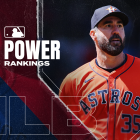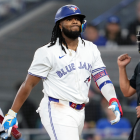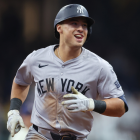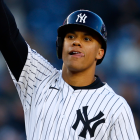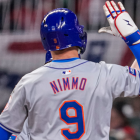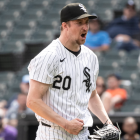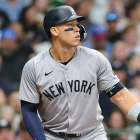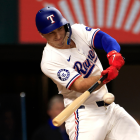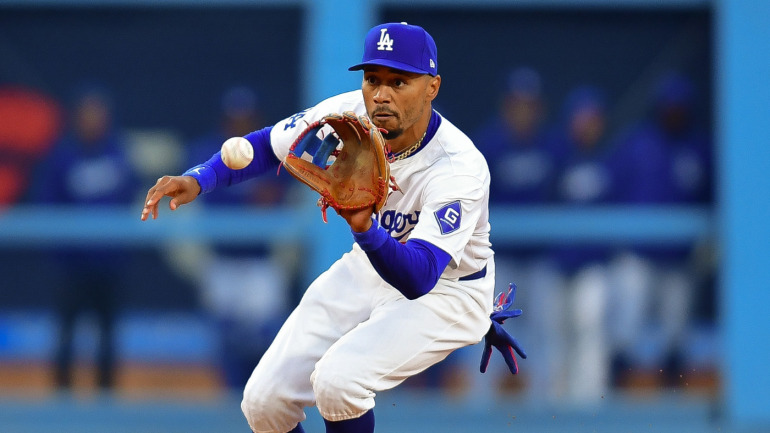
Nine games into the new season, the Los Angeles Dodgers are as advertised. They are 7-2 and they've scored at least five runs in every game, and that's without Shohei Ohtani doing much of anything. The $700 million man finally hit his first home run as a Dodger until Wednesday. Even with that, he has a mortal .750 OPS. Regardless, the Dodgers are a powerhouse, as expected.
And also as expected, the infield defense has been at best suspect and at worst a liability. Freddie Freeman is a tremendous defender at first base and he is the only Dodgers' infielder playing his natural position. Max Muncy is a first baseman masquerading as a third baseman, Mookie Betts is a right fielder playing shortstop, and no one seems to know where Gavin Lux fits best.
"I think it's the area that will probably take up most of our attention and focus," president of baseball operations Andrew Friedman said about the team's infield defense last week (via the Orange County Register). "We're optimistic that we've got the right personnel to make it work well. But obviously it's something we'll monitor and continue to stay on top of as we go."
The plan going into spring training had Betts at second base and Lux at shortstop, though Lux had trouble making routine throws in spring training -- this is an issue dating back to his days as a prospect -- so the Dodgers flipped them. Manager Dave Roberts called the move "permanent, for now." Even at second base, Lux is still shorthopping throws over to first.
"I think I just need to keep getting game reps," Lux, who missed the entire 2023 season after tearing his ACL in spring training, said about his throwing issues during the spring (via The Athletic). "I think just getting out there and continuing to play, it's knocking rust off more than anything ... It's just knocking rust off. I haven't done it for a year and a half."
As for Muncy, he is certainly experienced at third base, though he has rated poorly there over the years, including amassing minus-10 outs above average from 2022-23, after moving to third full-time in deference to Freeman. Lux's throws are an adventure, but he does typically field the ball cleanly. With Muncy, simply getting glove on the ball is an issue.
Muncy played a fair amount of second base from 2019-22 and was playable there thanks to the shift. The Dodgers could load up the right side of their infield and mitigate his lack of range. Shifts are gone now though, and every infielder is responsible for his position. The Dodgers can no longer "hide" Muncy at second base and must play him at third.
Betts has been the club's most reliable non-Freeman infielder defensively and while he's more than held his own at shortstop, it hasn't looked particularly natural. And that's understandable. Mookie played 98 innings at short last season, or roughly 11 games worth, and prior to that he hadn't played the position since Single-A in 2012. He's essentially learning shortstop on the fly.
"It's just a lot of responsibility out here," Betts, a six-time Gold Glover in right field, said recently about playing short (via the Los Angeles Times). "... I'm out there (making mistakes while taking ground balls before games). But when you get in the game, you just try to put it all together. That's what makes it fun. Making mistakes and learning from them."
In Miguel Rojas, the Dodgers do have a standout defensive shortstop who played the position during Lux's absence last year. In the early days of 2024, the lefty-hitting Lux and righty-hitting Rojas are in a platoon. Rojas has made three starts in nine games, all three at short (with Betts at second base) and against left-handed pitchers. Tuesday night, he replaced Lux for defense in the ninth inning with a one-run lead. It was the first time the Dodgers used Rojas as a true defensive replacement.
What do the Dodgers do about their infield defense? What can they even do? Let's assess the situation and see what the Dodgers can do with their mishmash of out of position infielders.
It's only been a week, stupid
Indeed, it has only been a week, and the shaky infield defense has yet to really bite the Dodgers, so who's to say it will even be a problem? At minimum, the early season numbers suggest there is no need to panic.
| Dodgers | MLB rank | |
|---|---|---|
Defensive efficiency | .704 | 15th |
BABIP on ground balls | .180 | 4th |
Infield outs above average | -1 | 19th |
Betts is a tremendous athlete and a smart and instinctual player, so chances are he'll grow more comfortable at shortstop as he spends more time there. Lux could iron out his throwing issues once he settles into the flow of the season. Muncy? Well, I'm not sure how much he can improve at third base, but Betts and Lux improving would ease any concerns about the infield.
Keep in mind the Dodgers' pitching staff should miss a lot of bats this season. Tyler Glasnow and Bobby Miller are premier strikeout artists and Gavin Stone and Yoshinobu Yamamoto project to rack up whiffs as well. Los Angeles ranks tenth with a team 24.1% strikeout rate and that number has been climbing. Strikeouts will lessen the reliance on the infield defense
Point is, the season is only a week old, and something we've identified as a potential problem has not yet manifested itself as an actual problem. There have been a few bad plays early on and that's it. The Dodgers' infield defense is not yet biting them every night. They're in position to remain patient and give their players a chance to settle in.
They can out-hit their defense
Indeed they can, and indeed they have through nine games. Muncy is unlikely to play even average defense at the hot corner, but as long as he's hitting game-winning home runs in the late innings, the Dodgers will live with his glove. This has been trade-off with him the last few years. Live with the defense because the bat makes up for it.
Betts is off to an incredible start this season: .485/.595/1.091 with five home runs and more walks (nine) than strikeouts (four). Lux hasn't done much at the plate yet (.200/.259/.240 in nine games), though he slashed .276/.349/.399 in close to 500 plate appearances as a 24-year-old in 2022. He was one of the top prospects in the game not too long ago and has considerable upside.
Basically, as long as these guys deliver at the plate and make up for any defensive shortcomings with offense, the Dodgers won't sweat a few booted ground balls or shorthopped throws. And if Betts and Muncy (and to a lesser extent Lux) don't perform offensively, Los Angeles will have a much bigger problem on their hands than infield defense.
What if it doesn't improve?
The Dodgers signed Muncy to a two-year extension last November, so there's really nothing they can do here other than keep him at third base. Freeman is locked in at first base and Ohtani is the DH. Muncy will be the third baseman unless his offense craters, or unless his defense is so bad it becomes untenable, and the Dodgers have no choice but to make a change.
Betts will be in the lineup one way or another. He's Mookie Betts. Worst case scenario, the Dodgers put him back in right field and take playing time away from Jason Heyward. They don't want to do that, but they will if they have to. Lux does not have the same luxury. At some point he'll have to start hitting or making true throws to first base. Ideally he'll do both, but let's start with one.
With Lux, the obvious alternative is Rojas. The Dodgers can slide Betts back over to second base, where he has more experience and looks more comfortable, and play Rojas at shortstop. That's more or less what they did last season. Rojas is not much of a hitter -- he slashed .236/.290/.322 in 2023 -- and he turned 35 in February, though he does have two home runs early on. That could earn him more playing time.
The Dodgers appear willing to give Lux a long runway to show he belongs in the lineup and is playable at second base, but if it doesn't come together over these next few weeks, chances are they will look outside the organization for infield help. They didn't give Ohtani and Yamamoto all that money only to ignore second base in the event Lux doesn't perform.
The obvious trade target would be Milwaukee Brewers shortstop Willy Adames, a gifted defender who can contribute on offense. The Brewers have started the season well themselves (they're 4-1), but Adames will be a free agent this winter, and they already have his heir apparent in Joey Ortiz. Even if they're in it, the Brewers could trade Adames to improve the roster elsewhere.
Other trade candidates like, say, New York Yankees infielder Oswald Peraza or Pittsburgh Pirates youngster Alika Williams would bring a quality glove, though the Dodgers already have a glove-first shortstop in Rojas. Odds are they would put him at short rather than trade for a different glove-first player, even a younger one with a little more offensive upside.
Trading for Adames and installing him at shortstop with Betts sliding over to second (and Lux going to Triple-A?) would be the most straightforward way to significantly improve the infield defense without sacrificing offense. That's something to keep in mind as we get closer to the deadline, and we see how the Dodgers and their infield defense situation unfolds.
For now, the infield defense stands out as an issue for the Dodgers, even if it hasn't hurt them in the standings yet. There's nothing they can do with Muncy other than live with him at third. Really, it's on Lux to show he deserves to stay in the lineup. As long as he hits, he'll play. If the bat doesn't come around, Los Angeles won't have much choice but to act at the deadline.














